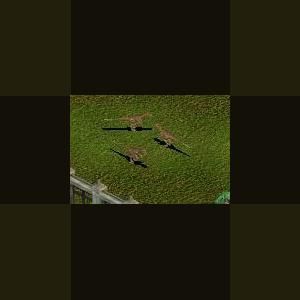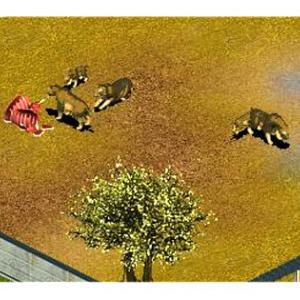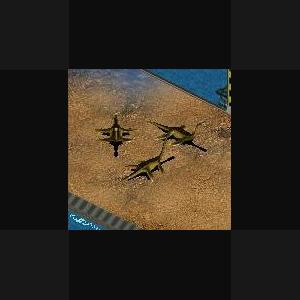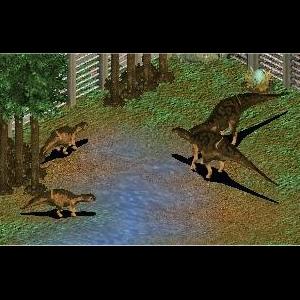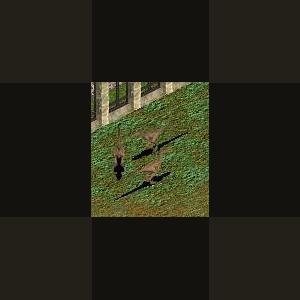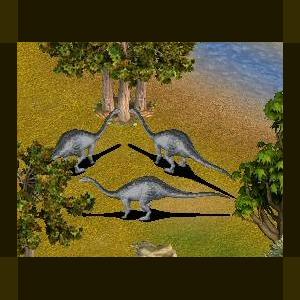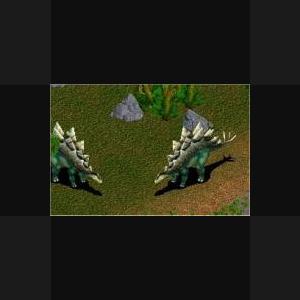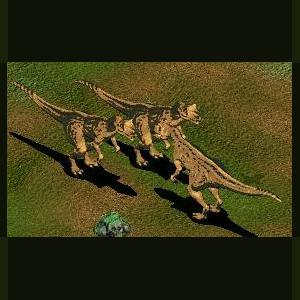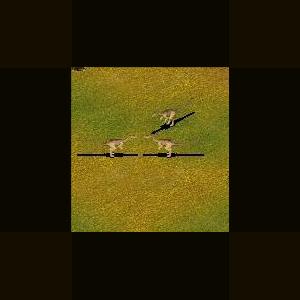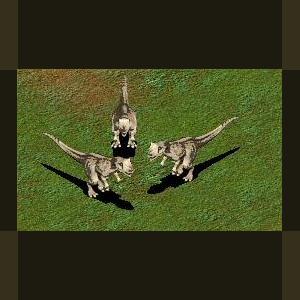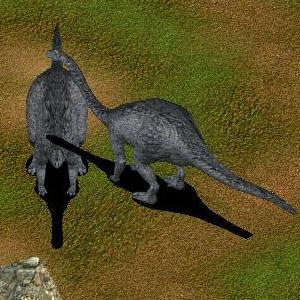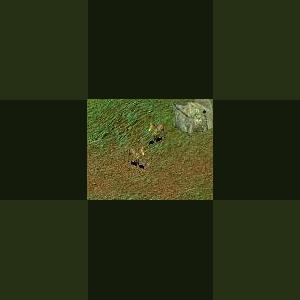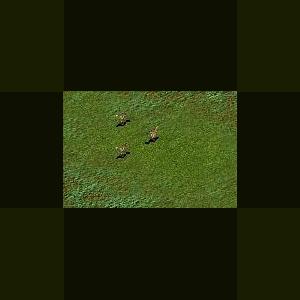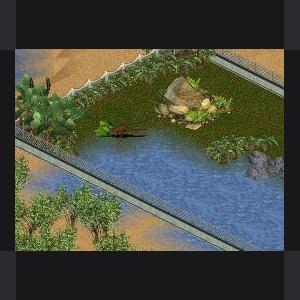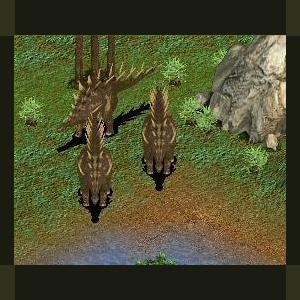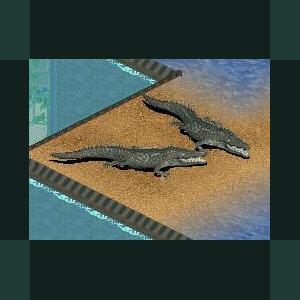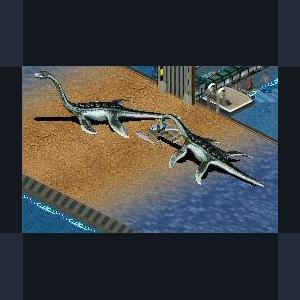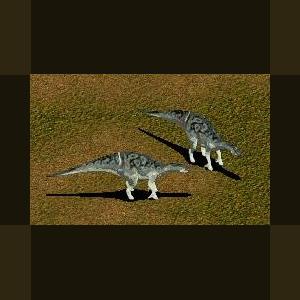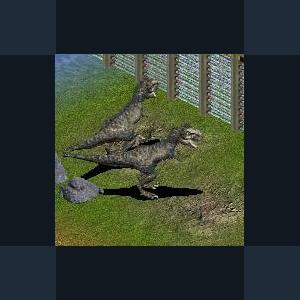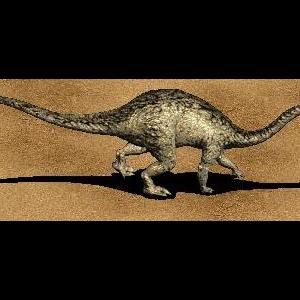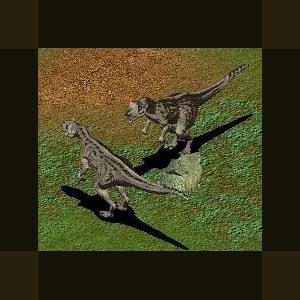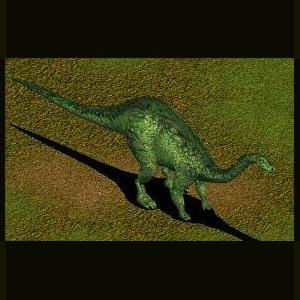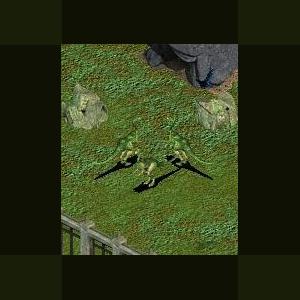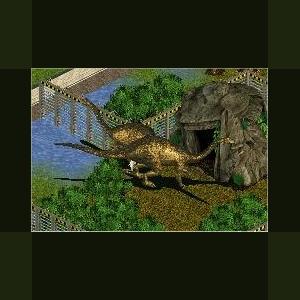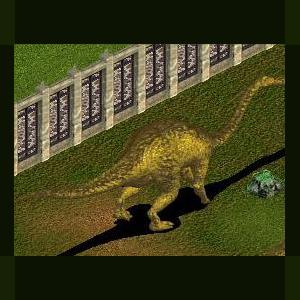Dinosaurs
Creatures from another age
241 files
-
Lycorhinus by Moondawg
By Guest
Lycorhinus angustidens is a heterodontosaurid ornithischian dinosaur hailing from the Early Jurassic strata of the Eliot Formation located in the Cape Province, South Africa.
The fossil remains consist in dentaries and maxillae hence the name that Haughton gave them in 1924, where the generic name means “wolf snout”, as it was at first misidentified as a cynodont, and the specific epithet means “constricted teeth”. Lycorhinus, including the remains described by Gow in 1975 as Lanasaurus, is a small herbivore dinosaur despite long canines it sported in its jaws; due to this unique characteristic L. angustidens is very clearly allied to Heterodontosaurus.
127 downloads
0 comments
Updated
-
Machairodus Giganteus by Ghirin
By Guest
Machairodus was a genus of large saber-toothed cats found in Eurasia, Africa and North America. These sabertooths thrived over the period covered by the mid-Miocene to the mid-Pliocene (15 to 2 million).
Machairodus giganteus, the size of a modern lion or tiger, was the largest and most specialized member the genus in Eurasia. Its skull was longer and narrower than a modern lion and the teeth had serrations along the edges.; in addition, M. giganteus also had longer legs than some other species of Machairodus. There was a small flange on either side of the chin to provide support for the sabers when the mouth was closed.
It lived in mixed habitats of savannah and broadleaf evergreen trees and might have had a lifestyle similar to that of modern lions. M. giganteus also might have had a tawny brown coat to help it blend in with its surroundings.
Referrences:
Big Cats and Their Fossil Relatives by Anton, Clark and Turner, 2000.
Mammoths, Sabertooths and Hominids by Agusti and Anton, 2002.
http://www.bluelion.org/lowgraphmachairodus.htm
Created by Ghirin 2003
395 downloads
0 comments
Updated
-
Macroplata by Moondawg
By Guest
Macroplata (mack-roh-PLAH-tah) is an extinct genus of Early Jurassic pliosaur, which grew up to 5 meters (15 ft) in length.
Like other pliosaurs, Macroplata probably lived on a diet of fish, using its sharp needle-like teeth to catch prey. Its shoulder bones were fairly large, indicating a powerful forward stroke for fast swimming. Macroplata also had a relatively long neck, twice the length of the skull, in contrast to later pliosaurs.
Two species are currently included in this genus: Macroplata tenuiceps, the type species, which lived during the Hettangian age (earliest Jurassic), and Macroplata longirostris, which lived somewhat later, during the Toarcian. However, it is thought that M. longirostris may be a distinct form which should be placed in a separate genus.
187 downloads
0 comments
Updated
-
Maiasaura by Ghirin
By Guest
Maiasaura
Author: Ghirin
http://www.zoo-tek.com/forums/index.php?download=782
Maiasaura ("Good Mother Lizard") formed large nesting colonies of up to 10,000 animals. Young Maiasaurs were cared for in the nest by adults until they were strong enough to follow the herd.
*Inspired by the Zoo Tycoon Brains Trust at the Zoo Tek Evolved Forums.*
362 downloads
0 comments
Updated
-
Masiakasaurus by Moondawg
By Guest
Masiakasaurus
Masiakasaurus was a small predatory (theropod) dinosaur from Madagascar, named in 2001. Unlike most theropods, the front teeth of Masiakasaurus projected forward instead of straight down. This unique dentition suggests that Masiakasaurus had a specialized diet, perhaps including fish and other small prey. Other bones of the skeleton indicate that Masiaksaurus was bipedal, with much shorter forelimbs than hindlimbs. Masiakasaurus had an estimated adult body length of around 2 meters (about 6-7 feet).
Masiakasaurus lived around 70 million years ago, along with animals such as Majungasaurus, Rapetosaurus, and Rahonavis. Masiakasaurus was closely related to the noasaurs, small predatory dinosaurs found in South America.
In Malagasy, masiaka means "vicious"; thus, the genus name means "vicious lizard". The type species, Masiakasaurus knopfleri, was named after the musician Mark Knopfler of Dire Straits fame, "whose music inspired expedition crews".
158 downloads
0 comments
Updated
-
Massospondylus by Moondawg
By Guest
Massospondylus
Massospondylus (Greek 'elongated vertebra'), formerly known as Aristosaurus, was an Early Jurassic Period prosauropod, although, if Aetonyx is the same as Massospondylus, it lived from the Late Triassic as well. It was probably a plant eater (herbivore), although it is speculated that the prosauropods may have been omnivorous. This dinosaur was named by Sir Richard Owen in 1854, from remains found in South Africa. It is thus one of the first dinosaurs to be named.
Massospondylus (pronounced,(masson, "longer") and (spondylos, "vertebra") is a genus of prosauropod dinosaur from the early Jurassic Period (Hettangian to Pliensbachian ages, ca. 200–183 million years ago). It was described by Sir Richard Owen in 1854 from remains found in South Africa, and is thus one of the first dinosaurs to have been named. Fossils have since been found at other locations in South Africa, Lesotho, and Zimbabwe. Further material from Arizona's Kayenta Formation, India, and Argentina has been assigned to this genus, but may not belong to Massospondylus.
The type, and only universally recognized, species, is M. carinatus, although six other species have been named during the past 150 years. Prosauropod systematics have undergone numerous revisions during the last several years, and many scientists disagree where exactly Massospondylus lies on the dinosaur evolutionary tree. The family name Massospondylidae was once coined for the genus, but because knowledge of prosauropod relationships is in a state of flux, it is unclear which other dinosaurs—if any—belong in a natural grouping of massospondylids; several 2007 papers support the family's validity.
Although Massospondylus was long depicted as quadrupedal, a 2007 study found it to be bipedal. It was probably a plant eater (herbivore), although it is speculated that the prosauropods may have been omnivorous. This animal, 4–6 meters (13–20 feet) long, had a long neck and tail, with a small head and slender body. On each of its forefeet, it bore a sharp thumb claw that was used in defense or feeding. Recent studies indicate Massospondylus grew steadily throughout its lifespan, possessed air sacs similar to those of birds, and may have cared for its young.
Massospondylus was a mid-sized prosauropod that was around 4 meters (13 ft) in length and weighed approximately 135 kilograms (300 lb), although a few sources have estimated its length at up to 6 meters (20 ft). Although long assumed to have been quadrupedal, a 2007 anatomical study of the forelimbs has questioned this, arguing that their range of motion precluded effective habitual quadrupedal gait. The study also ruled out the possibility of "knuckle-walking" and other forms of locomotion that would avoid the issue of the limited ability of Massospondylus to pronate its hands. Although its mass suggests a quadrupedal nature, it would have been restricted to its hind legs for locomotion.
Massospondylus was a typical prosauropod in most other respects. It possessed a slender body and long neck, with around nine long cervical (neck) vertebrae, 13 dorsal (back) vertebrae, three sacral (hip) vertebrae, and at least 40 caudal (tail) vertebrae. The pubis faced forward, as with most saurischians. It had a slighter build than that of Plateosaurus, an otherwise similar prosauropod dinosaur. A recent discovery shows that Massospondylus possessed well-developed clavicles, joined in a furcula-like arrangement, suggesting both that it had immobile shoulder blades and that clavicles were not rudimentary and nonfunctional in those dinosaurs that did not have true furculae. This discovery also indicates that the furcula of birds is derived from clavicles.
Like Plateosaurus, it had five digits on each foot, with a large thumb claw used for feeding or defense against predators. The fourth and fifth digits of the forepaws were tiny, giving the forepaws a lopsided look. The 2007 study indicated that Massospondylus held its manus (hands) in a semi-supinated ("prayer-like") orientation, with the palmar surfaces facing one another; the wrist was never found rotated in articulated (still-connected) fossil specimens.
The small head of Massospondylus was approximately half the length of the femur. Numerous openings, or fenestrae, in the skull reduced its weight and provided space for muscle attachment and sensory organs. These fenestrae were present in pairs, one on each side of the skull. At the front of the skull were two large, elliptical nares. The orbits were proportionally larger in Massospondylus than in related genera such as Plateosaurus. The antorbital fenestrae, smaller than those seen in Plateosaurus, were situated between the eyes and the nose. At the rear of the skull were two more pairs of temporal fenestrae: the lateral temporal fenestrae immediately behind the eye sockets and the supratemporal fenestrae on top of the skull. Small fenestrae also penetrated each mandible. The shape of the skull is traditionally restored as wider and shorter than that of Plateosaurus, but this appearance may be due just to differential crushing experienced by the various specimens.Some features of the skull are variable between individuals; for example, the thickness of the upper border of the orbit and the height of the posterior maxilla. These differences may be due to sexual dimorphism or individual variation.
As with other prosauropods, it has been proposed that Massospondylus had cheeks. This theory was proposed because there are a few large holes for blood vessels on the surfaces of the jaw bones, unlike the numerous small holes present on the jaws of cheekless reptiles. The cheeks would have prevented food from spilling out when Massospondylus ate. Crompton and Attridge (1986) described skulls of Massospondylus as possessing pronounced overbites and suggested the presence of a horny beak on the tip of the lower jaw to make up the difference in length and account for tooth wear on the teeth at the tip of the snout. However, this was later shown to be a misinterpretation based on crushing in a top–bottom plane. Skulls not crushed in this orientation do not show an overbite. There also seems to be some variation of tooth morphology based on the position of teeth in the jaw. The heterodonty present in Massospondylus is greater than that present in Plateosaurus, although unsurprisingly not as pronounced as the specialization of teeth in Heterodontosaurus. Teeth closer to the front of the snout had round cross-sections and tapered to points, unlike the back teeth, which were spatulate and had oval cross-sections.
Many species have been named, although most are no longer considered valid. M. carinatus, named by Richard Owen, is the type species. Other named species include: M. browni (Seeley, 1895), M. harriesi (Broom 1911), M. hislopi (Lydekker, 1890), M. huenei (Cooper, 1981), M. rawesi (Lydekker, 1890), and M. schwarzi (Haughton, 1924).
M. browni, M. harriesi, and M. schwarzi were all found in the Upper Elliot Formation of Cape Province, South Africa. All three are based on fragmentary material, and were regarded as indeterminate in the most recent review. M. browni is based on two cervical, two back, and three caudal vertebrae and miscellaneous hind limb elements. M. harriesi is known from a forelimb.M. schwarzi is known from an incomplete hind limb and sacrum. M. hislopi and M. rawesi were named from fossils found in India. M. hislopi is based on vertebrae from the Upper Triassic Maleri Formation of Andhra Pradesh, whereas M. rawesi is based on a tooth from the Upper Cretaceous Takli Formation of Maharashtra. M. hislopi was tentatively retained as an indeterminate sauropodomorph in the latest review,but M. rawesi may be a theropod or nondinosaur. M. huenei is a combination derived by Cooper for Lufengosaurus huenei, as he considered Lufengosaurus and Massospondylus to be synonyms. This synonymy is no longer accepted.
Several dinosaurs are often considered synonymous with Massospondylus. These include Aristosaurus, Dromicosaurus, Gryponyx, Hortalotarsus, Leptospondylus, and Pachyspondylus, which are dubious names of little scientific value. Hortalotarsus skirtopodus was named by Harry Seeley in 1894. The fossils consist of partial leg bones. The following year, Richard Owen named a few fossil vertebrae Leptospondylus capensis and Pachyspondylus orpenii. These fragmentary fossils were later destroyed in World War II. Aristosaurus erectus was named by E.C.N. van Hoepen in 1920 based on a nearly complete skeleton. Hoepen also named Dromicosaurus gracilis, which consisted of a partial skeleton. Gryponyx taylori was named by Sidney H. Haughton in 1924. It consists of hip bones. All of the above fossils come from the Hettangian or Sinemurian faunal stages of South Africa, where Massospondylus has been found. Under the rules of zoological nomenclature, these names are junior synonyms. They were named after Massospondylus was described in a scientific paper; the name Massospondylus thus takes priority.
Massospondylus is a prosauropod, a grouping of early saurischian dinosaurs that lived during the Triassic and Jurassic, but which had died out by the end of the Jurassic. Other members of the group include Plateosaurus, Yunnanosaurus, and Riojasaurus. Basal sauropodomorph systematics continue to undergo revision, and many genera once considered classic prosauropods have recently been removed from the group in phylogenetic nomenclature, on the grounds that their inclusion would not constitute a clade (a natural grouping containing all descendants of a single common ancestor). Exactly which animals constitute a monophyletic (natural grouping) of prosauropods is unclear. Yates and Kitching (2003) published a clade consisting of Riojasaurus, Plateosaurus, Coloradisaurus, Massospondylus, and Lufengosaurus. Galton and Upchurch (2004) included Ammosaurus, Anchisaurus, Azendohsaurus, Camelotia, Coloradisaurus, Euskelosaurus, Jingshanosaurus, Lessemsaurus, Lufengosaurus, Massospondylus, Melanorosaurus, Mussaurus, Plateosaurus, Riojasaurus, Ruehleia, Saturnalia, Sellosaurus, Thecodontosaurus, Yimenosaurus and Yunnanosaurus in a monophyletic Prosauropoda. Wilson (2005) considered Massospondylus, Jingshanosaurus, Plateosaurus, and Lufengosaurus a natural group, with Blikanasaurus and Antetonitrus possible sauropods. Bonnan and Yates (2007) considered Camelotia, Blikanasaurus and Melanorosaurus possible sauropods. Yates (2007) placed Antetonitrus, Melanorosaurus, and Blikanasaurus as basal sauropods and declined to use the term Prosauropoda, as he considered it synonymous with Plateosauridae. However, he did not rule out the possibility that a small group of prosauropods consisting of Plateosaurus, Riojasaurus, Massospondylus and their closest kin were monophyletic.
Massospondylus is the type genus of the proposed family Massospondylidae, to which it gives its name. The Massospondylidae family may also include Yunnanosaurus, although Lu et al. (2007) placed Yunnanosaurus in its own family. Yates (2007) considered Massospondylus, Coloradisaurus, and Lufengosaurus massospondylids, with Yunnanosaurus in Anchisauria. Smith and Pol (2007) also found a Massospondylidae in their phylogenetic analysis, including Massospondylus, Coloradisaurus, and Lufengosaurus, as well as their new genus, Glacialisaurus.Adeopapposaurus, based on the fossils once thought to belong to a South American form of Massospondylus, was also classified as a massospondylid.
The faunas and floras of the Early Jurassic were similar worldwide, with conifers adapted for hot weather becoming the common plants, and prosauropods and basal theropods the main constituents of a worldwide dinosaur fauna. The environment of early Jurassic southern Africa has been described as a desert. African Massospondylus was a contemporary of early crocodylomorphs; tritylodontid and trithelodontid therapsids; morganucodontid mammals; and dinosaurs including the small theropod Megapnosaurus rhodesiensis; a species of Melanorosaurus (M. thabanensis); and several genera of early ornithischians, such as Lesothosaurus and the heterodontosaurids Abrictosaurus, Heterodontosaurus, and Lycorhinus.
It is not clear which carnivores may have preyed on Massospondylus. Most of the theropods which have been discovered in rocks of Early Jurassic age in southern Africa, such as Megapnosaurus, were smaller than mid-sized prosauropods like Massospondylus. These smaller predators have been postulated as using fast slashing attacks to wear down prosauropods, which could have defended themselves with their large hand and foot claws. The 6-meter-(20 ft-) long carnivorous theropod Dracovenator lived during the same period (Hettangian to Sinemurian stages) as Massospondylus and has also been found in the Elliot Formation of South Africa.
As with all dinosaurs, much of the biology of Massospondylus, including its behavior, coloration, and physiology, remains unknown. However, recent studies have allowed for informed speculation on subjects such as growth patterns, diet,posture, reproduction, and respiration.
A 2007 study suggested that Massospondylus may have used its short arms in defense from predators ("defensive swats"), in intraspecies combat, or in feeding, although its arms were too short to reach its mouth. Scientists speculate that Massospondylus could have used its large pollex (thumb) claw in combat, to strip plant material from trees,digging, or for grooming.
A 2005 study indicated that Massospondylus' sister taxon, Plateosaurus, exhibited growth patterns affected by environmental factors. The study indicated that when food was plentiful, or when the climate was favorable, Plateosaurus exhibited accelerated growth. This pattern of growth is called "developmental plasticity". It is unseen in other dinosaurs, including Massospondylus, despite the close relationship between Plateosaurus and Massospondylus. The study indicated that Massospondylus grew along a specific growth trajectory with little variation in the growth rate and ultimate size of an individual.Another study of age determination indicated that Massospondylus grew at a maximum rate of 34.6 kg (76.3 lb) per year and was still growing at around 15 years of age.
Prosauropods such as Massospondylus may have been herbivorous or omnivorous. As recently as the 1980s, paleontologists debated the possibility of carnivory in prosauropods. However, the hypothesis of carnivorous prosauropods has been discredited, and all recent studies favor a herbivorous or omnivorous lifestyle for these animals. Galton and Upchurch (2004) found that cranial characteristics (such as jaw articulation) of most prosauropods are closer to those of herbivorous reptiles than those of carnivorous ones, and the shape of the tooth crown is similar to those of modern herbivorous or omnivorous iguanas. The maximum width of the crown was greater than that of the root, resulting in a cutting edge similar to those of extant herbivorous or omnivorous reptiles. Barrett (2000) proposed that prosauropods supplemented their herbivorous diets with small prey or carrion. Gastroliths (gizzard stones) have been found in association with Massospondylus fossils in South Africa, and with a Massospondylus-like animal from the Late Triassic of Virginia. Massospondylus swallowed these stones to aid in digestion; muscular contractions in the creature's gizzard would have pulverized swallowed plant material, compensating for its inability to chew.
In 1977, seven 190-million-year-old Massospondylus eggs were found in Golden Gate Highlands National Park in South Africa by James Kitching, who identified them as most likely belonging to Massospondylus. It was nearly 30 years before extraction was started on the fossils of the 15-centimeter- (6 in-) long embryos. They remain the oldest dinosaur embryos ever found. Notably, the near-hatchlings had no teeth, suggesting they had no way of feeding themselves. Based on the lack of teeth and the animal's body proportions, scientists speculate that postnatal care might have been necessary. The four legs of the near-hatchlings were of equal length, indicating that newly hatched Massospondylus were quadrupedal. The skull and eyes were proportionately oversized when compared to adults, as is common in other very young vertebrates, although the skulls of juveniles were taller and more narrow as well. The quadrupedality of the hatchlings suggests that the quadrupedal posture of later sauropods may have evolved from retention of juvenile characteristics in adult animals, an evolutionary phenomenon known as pedomorphosis.
Many saurischian dinosaurs possessed vertebrae and ribs that contained hollowed-out cavities (pneumatic foramina), which reduced the weight of the bones and may have served as a basic 'flow-through ventilation' system similar to that of modern birds. In such a system, the neck vertebrae and ribs are hollowed out by the cervical air sac; the upper back vertebrae, by the lung; and the lower back and sacral (hip) vertebrae, by the abdominal air sac. These organs constitute a complex and very efficient method of respiration. Prosauropods are the only major group of saurischians without an extensive system of pneumatic foramina. Although possible pneumatic indentations have been found in Plateosaurus and Thecodontosaurus, the indentations were very small. One study in 2007 concluded that prosauropods like Massospondylus likely had abdominal and cervical air sacs, based on the evidence for them in sister taxa (theropods and sauropods). The study concluded that it was impossible to determine whether prosauropods had a bird-like flow-through lung, but that the air sacs were almost certainly present.
194 downloads
0 comments
Updated
-
Mbielu-Mbielu-Mbielu by Ghirin
By Guest
Mbielu-mbielu-mbielu by Ghirin
The name Mbielu-mbielu-mbielu means "the animal with planks growing out of its back."
This cryptid is from the Likouala swamp region of the Republic of Congo. The exact nature of Mbielu-mbielu-mbielu is unknown. Some think that it is similar to a stegosaur while others think that the cryptid is snake-like.
References:
www.wikipedia.org
http://www.cryptozoology.net/english/afric...u/overview.html
*Inspired by Professor Paul's Nature Encyclopedia*
185 downloads
0 comments
Updated
-
Megalosaurus by Moondawg
By Guest
Megalosaurus (meaning "Great Lizard", from Greek,megalo- meaning 'big', 'tall' or 'great' and sauros meaning 'lizard') is a genus of large meat-eating theropod dinosaurs of the Middle Jurassic Period (Bathonian) o
Megalosaurus was the first dinosaur to be described. Part of a bone was recovered from a limestone quarry at Cornwell near Chipping Norton, Oxfordshire, England in 1676. The fragment was sent to Robert Plot, Professor of Chemistry at the University of Oxford and first curator of the Ashmolean Museum, who published a description in his Natural History of Oxfordshire in 1677. He correctly identified the bone as the lower extremity of the femur of a large animal and he recognized that it was too large to belong to any known species; he considered it to be the thigh bone of a giant. The bone has since been lost but the illustration is detailed enough to identify it clearly as the femur of a Megalosaurus.
The Cornwell bone was described again by Richard Brookes in 1763. He named it Scrotum humanum, while describing its similar appearance to a pair of human testicles. The label was not considered to be a "name" for the animal in question at the time, and was not used in subsequent literature. Technically, the name was published after the advent of binomial nomenclature, and although this name theoretically had priority over Megalosaurus, the rules of the ICZN state that if a name falls into disuse for 50 years after publication, it is no longer in competition for priority. Therefore, the name Scrotum humanum is a nomen oblitum, or "forgotten name".
More discoveries were made, starting in 1815, again at the Stonesfield quarry. They were acquired by William Buckland, Professor of Geology at the University of Oxford and dean of Christ Church. He did not know to what animal the bones belonged but, in 1818, after the Napoleonic Wars, the French comparative anatomist Georges Cuvier visited Buckland in Oxford and realised that the bones belonged to a giant lizard-like creature. Buckland then published descriptions of the bones in Transactions of the Geological Society, in 1824 (Physician James Parkinson had described them in an article in 1822).
242 downloads
0 comments
Updated
-
Megapnosaurus by Moondawg
By Guest
Megapnosaurus
Megapnosaurus (meaning "big dead lizard", from Greek = "big", = "not breathing", "dead", = "lizard") was a dinosaur of the theropod family Coelophysidae, formerly called Syntarsus (named by Raath, 1969), living during the Early Jurassic. It was renamed by American entomologist Dr. Michael Ivie (Montana State University of Bozeman), Polish Australian Dr. Adam Slipinski, and Polish Dr. Piotr Wegrzynowicz (Muzeum Ewolucji Instytutu Zoologii PAN of Warsaw), the scientists who discovered that the genus name Syntarsus was already taken by a colydiine beetle described in 1869.
Some paleontologists did not like the name Megapnosaurus. This was partially because taxonomists are generally expected to allow original authors of a name to correct any mistakes that may have arisen from their work. Raath was aware of the synonymy between the dinosaur Syntarsus and beetle Syntarsus, but the group who published Megapnosaurus had been led to believe Raath was deceased and proceeded accordingly. Megapnosaurus remains a valid name, though whether it can be treated as synonymous with Coelophysis is an open question.
It is almost identical to Coelophysis, and Yates (2005) suggested that Megapnosaurus was possibly synonymous with Coelophysis. In 2004, Raath co-authored two papers in which he argued that "Syntarsus" (Raath continued to use the old, invalid, name) was a junior synonym of Coelophysis.
Megapnosaurus measured up to 3 meters (10 ft) long from nose to tail and weighed about 32 kilograms (70 lb). The bones of 30 Megapnosaurus individuals were found together in a fossil bed in Zimbabwe, so paleontologists think it may have hunted in packs. The various fossils attributed to Megapnosaurus have been dated over a relatively large time span - the Hettangian, Sinemurian, and Pliensbachian stages of the Early Jurassic - meaning the fossils represent either a highly successful genus or a few closely related animals all currently assigned to Megapnosaurus.
Megapnosaurus is a good example of how dinosaurs spread across the globe from their ancestral habitats (which was possibly South America). This small predator had the same basic features found in early dinosaurs, and its appearance in both Africa and the southwestern U.S. indicates that it migrated through the continents, which at the time were joined together as Pangaea. There is species-level differentiation between the African and U.S. specimens, again supporting the migration and adaptation theories.
The African species (M. rhodesiensis) is known from almost 30 specimens. The North American species (M. kayentakatae) had small crests and may show an evolutionary step toward later and larger coelophysoids, such as the more derived Dilophosaurus. Both possess a weak joint between the premaxillary and the maxillary bones, creating a hooked premaxillary jaw. This led to the early hypothesis that dinosaurs such as these were scavengers, as the front teeth and bone structure were thought to be too weak to take down and hold struggling prey.
137 downloads
0 comments
Updated
-
Megaraptor by Moondawg
By Guest
Megaraptor ("giant thief") was once thought to be the largest dromaeosaur ever found, but is now known to be a carnosaur related to Allosaurus.
It lived in Late Cretaceous times in the Patagonian region of Argentina. It was a contemporary of Giganotosaurus, one of the largest carnivorous dinosaurs of all time.
Megaraptor was initially described as a giant dromaeosaur, known primarily from a single claw (about 1ft long) that resembled the sickle-shaped foot claw of dromaeosaurids. The discovery of a complete front limb, however, showed that this giant claw actually came from the first finger of the hand. The hands were unusually elongated, bore sickle-shaped claws even more recurved than those of spinosaurids.The hand is quite distinct from other basal tetanurans, so it is not clear whether Megaraptor is an allosaurid, a carcharodontosaurid, a spinosauroid, or something else entirely.
It should be noted that, when first discovered and prior to publication, the spinosaurid Baryonyx was also reported to be a dromaeosaurid, again based on a large hand claw.
Megaraptor's size is debated. However, most experts have come to agree that Megaraptor is approximately 8 meters (26 feet) in length and 3 meters (10 feet) in height.
189 downloads
0 comments
Updated
-
Melanorosaurus by Moondawg
By Guest
Melanorosaurus
Melanorosaurus, "Black Mountain Lizard", from the (Greek melano "black", "mountain" + saurus"lizard", was a 12 meter long sauropod dinosaur that lived in the Late Triassic period. A herbivore from South Africa, it had a great body and sturdy limbs, suggesting it moved about on all fours. Limb bones were massive and weighty, like sauropod limb bones. But, like most sauropods vertebrae, its spinal bones had hollows that helped reduce weight. Unfortunately, a skull has not been found to date.
The type specimen was described in 1924, having been collected from the Upper Triassic Elliot Formation on the north slope of the Thaba 'Nyama (Black Mountain) in Transkei, South Africa. It wasn't until 2007 when the first complete skull of Melanorosaurus was described.[1] Two species are known: M. readi, the type species, and M. thabanensis.
Melanorosaurus was once classified as a prosauropod, but is now recognized as one of the earliest known sauropods. Once thought to be an ancestral basal assemblage to the sauropods, differences in e.g. the design of their ankle bones point out that these are sister groups. Basal sauropods such as Melanorosaurus, Anchisaurus and Antetonitrus are intermediate between these groups.
Melanorosaurus had a skull which measured approximately 250 mm. The snout was somewhat pointed, and the skull was somewhat triangular when seen from above or below. The premaxilla had four teeth on each side, a characteristic of primitive sauropodomorphs. The maxilla had 19 teeth on each side of the jaw.
Melanorosaurus was around 12 meters long.
164 downloads
0 comments
Updated
-
Merychippus by Moondawg
By Guest
Merychippus is a proto-horse that lived between 17 and 11 million years ago in the Miocene period.
It had three toes on each foot and is the first horse known to have grazed. Its name means "ruminant horse", but it is not now thought that Merychippus ruminated.
Merychippus lived in herds. It was about twelve hands (48 inches) tall; at the time it was the tallest equine to have existed. The muzzle was longer, the jaw deeper, and the eyes wider apart than any other horse-like animal to date. The brain was also much larger, making it smarter and more agile. Merychippus was the first equine to have the distinctive head of today's horses. The foot was fully supported by ligaments, and the middle toe developed into a hoof, which did not have a pad on the bottom. In some Merychippus species, the side toes were larger, whereas in others, they had become smaller and only touched the ground when running. Its teeth were like those of Parahippus (the extra crest that was variable in Miohippus was permanent in Merychippus, and the other teeth were beginning to form a series of tall crests with higher crowns).
202 downloads
0 comments
Updated
-
Microraptor by Moondawg
By Guest
Microraptor had two sets of wings, on both its fore- and hind legs. The long feathers on the legs of Microraptor were true flight feathers as seen in modern birds, with asymmetrical vanes on the arm, leg, and tail feathers. As in bird wings, Microraptor had both primary (anchored to the hand) and secondary (anchored to the arm) flight feathers. This standard wing pattern was mirrored on the hind legs, with flight feathers anchored to the upper foot bones as well as the upper and lower leg. It had been proposed by Chinese scientists that the animal glided, and probably lived in trees, pointing to the fact that wings anchored to the feet of Microraptor would have hindered their ability to run on the ground, and suggest that all primitive dromaeosaurids may have been arboreal.
Sankar Chatterjee determined in 2005 that, in order for the creature to glide or fly, the wings must have been split-level (like a biplane) and not overlayed (like a dragonfly), and that the latter posture would have been anatomically impossible. Using this biplane model, Chatterjee was able to calculate possible methods of gliding, and determined that Microraptor most likely employed a phugoid style of gliding--launching itself from a perch, the animal would have swooped downward in a deep 'U' shaped curve and then lifted again to land on another tree. The feathers not directly employed in the biplane wing structure, like those on the tibia and the tail, could have been used to control drag and alter the flight path, trajectory, etc. The orientation of the hind wings would also have helped the animal control its gliding flight. Chatterjee also used computer algorithms that test animal flight capacity to test whether or not Microraptor was capable of true, powered flight, in addition to passive gliding. The resulting data showed that Microraptor did have the requirements to sustain level powered flight, so it is theoretically possible that the animal flew on occasion in addition to gliding.
Some paleontologists have suggested that feathered dinosaurs used their wings to parachute from trees, possibly in order to attack or ambush prey on the ground, as a precursor to gliding or true flight. In their 2007 study, Chatterjee and Templin tested this hypothesis as well, and found that the combined wing surface of Microraptor was too narrow to successfully parachute to the ground without injury from any significant height. However, the authors did leave open the possibility that Microraptor could have parachuted short distances, as between closely spaced tree branches.
Chatterjee and Templin also ruled out the possibility of a ground-based takeoff. Microraptor lacked the necessary adaptations in its shoulder joint to lift its front wings high enough vertically to generate lift from the ground, and the authors argued that a ground-based takeoff would have damaged flight feathers on the feet. This leaves only the possibility of launching from an elevated perch, and the authors noted that even modern birds do not need to use excess power when launching from trees, but use the downward-swooping technique they found in Microraptor.
The unique wing arrangement found in Microraptor raised the question of its importance to the origin of flight in modern birds--did avian flight go through a four-winged stage, or were four-winged gliders like Microraptor an evolutionary side-branch that did not leave descendants? As early as 1915, some scientists had argued that the evolution of bird flight may have gone through a four-winged (or tetrapteryx) stage. Chatterjee and Templin did not take a strong stance on this possibility, noting that both a conventional interpretation and a tetrapteryx stage are equally possible. However, based on the presence of unusually long leg feathers in various feathered dinosaurs, Archaeopteryx, and some modern birds such as raptors, as well as the discovery of Pedopenna (another dinosaur with long primary feathers on its feet), the authors argued that the current body of evidence, both from morphology and phylogeny, suggests that bird flight did shift at some point from shared limb dominance to front-limb dominance, and that all modern birds may have evolved from four-winged ancestors, or at least ancestors with unusually long leg feathers relative to the modern configuration.
The naming of Microraptor is controversial, because of the unusual circumstances of its first description. The first specimen to be described was part of a chimeric specimen , a patchwork of unrelated feathered dinosaur species assembled from multiple specimens in China and smuggled to the USA for sale. After the forgery was revealed by Xu Xing of Beijing's Institute of Vertebrate Paleontology and Paleoanthropology, Storrs L. Olson, curator of birds in the National Museum of Natural History of the Smithsonian Institution, published a description of the tail in an obscure journal, giving it the name Archaeoraptor liaoningensis in an attempt to remove the name from the paleornithological record by assigning it to the part least likely to be a bird. However, Xu had discovered the remainder of the specimen from which the tail had been taken and published a description of it later that year, giving it the name Microraptor zhaoianus.
Since the two names designate the same individual as the type specimen, Microraptor zhaoianus is a junior objective synonym of Archaeoraptor liaoningensis and the latter, if valid, has priority. So, according to some interpretations of the International Code of Zoological Nomenclature, the valid name for this dinosaur probably is Archaeoraptor liaoningensis Olson 2000. However, there is some doubt whether Olson in fact succeeded in meeting all the formal requirements for establishing a new taxon. Most paleontologists are unwilling to use the name Archaeoraptor regardless of the precise legal status of the name. This is firstly because that name is strongly associated with the fraud and the National Geographic scandal and secondly because they view Olson's use of the name as attempted nomenclatural sabotage and do not want to support it. The name Microraptor zhaoianus Xu et al., 2000 has therefore almost attained universal currency.
307 downloads
0 comments
Updated
-
Mokele Mbembe by Ghirin
By Guest
Mokele-mbembe, a name that means "One who stops the flow of rivers", is a legendary animal from the Likouala swamp region of the Central African Republic. It is usually described as having a small head on a long neck, a long, tail, rounded feet with three claws on each foot, and to be intermediate in size between an elephant and a hippopatamus The skin is hairless and reddish brown in color.
Mokele-mbembe is said to live in the pools and wetlands near rivers. It is herbivorous, prefering the malambo plant (Landolphia sp.). The animal is reported to spend most of its time in the water, only coming onto dry land to feed.
Some cryptozoologists believe that Mokele-mbembe is a surviving population of sauropod dinosaurs from the Mesozoic era. Many reports of the creature have come from the Congo region and several expeditions have been organized, but no actual specimenes, living or dead have been recovered for scientific study.
*Inspired by the Zoo Tycoon Brains Trust at the Zoo Tek Forums.
References:
http://www.mokelembembe.com/
http://www.geocities.com/Area51/Cavern/7270/mokele.html
http://www.angelfire.com/mi/dinosaurs/mokele.html
http://www.occultopedia.com/m/mokele_mbembe.htm
Created by Ghirin 2004
327 downloads
0 comments
Updated
-
Monkonosaurus by Moondawg
By Guest
Monkonosaurus
Monkonosaurus (meaning "Monkon lizard") is the name given to a genus of dinosaur from the Late Jurassic (Kimmeridgian stage, around 150-155 million years ago). It was a stegosaur which lived in what is now Tibet. The type specimen, Monkonosaurus lawulacus was formalized by Zhao in 1983, but is based only on one partial skeleton.The fragmentary condition of this single skeleton places doubt on the validity of this genus.
158 downloads
0 comments
Updated
-
Mourasuchus by Moondawg
By Guest
Mourasuchus is an extinct genus of giant crocodilian from the Miocene of South America.
231 downloads
0 comments
Updated
-
Muraenosaurus by Moondawg
By Guest
Muraenosaurus ('moray eel lizard') is an extinct genus of sauropterygian reptile belonging to the plesiosaur order. It lived in Late Jurassic Europe, and grew to 30 feet (8 m) long. Half of its length was its neck, which consisted of 44 vertebrae. Its skull was small.
246 downloads
0 comments
Updated
-
Naashoibitosaurus by Moondawg
By Guest
Naashoibitosaurus (meaning in Navajo na‘asho‘i "lizard creek") is a genus of hadrosaurid dinosaur that lived about 73 million years ago.
Naashoibitosaurus, based as it is on a single partial skeleton, is not well-known in terms of anatomy. Its skull, the most thoroughly described portion, has a low nasal crest that peaks in front of the eyes, but does not strongly arch as in Gryposaurus.
Naashoibitosaurus is a hadrosaurine hadrosaurid, a "flat-headed or solid-crested duckbill". It is closest to the solid-crested forms like Saurolophus. If it is the same as Kritosaurus, Kritosaurus would be used because it is the older name, but its position vis-a-vis other duckbills would be the same.
Befitting a genus with a confusing taxonomic history, the name of this genus is based on an error. David Gillette and David Thomas collected the type and only known specimen from what was thought to be the Naashoibito Member of the Kirtland Formation, the youngest member of the Kirtland; this was commemorated in the name. Instead, it came from the older, late Campanian-age De-na-zin Member. Horner described the skull in 1992 as that of an immature Kritosaurus, using it as evidence that Gryposaurus was different from Kritosaurus. At the same time, Hunt and Lucas were describing the postcrania as belonging to Edmontosaurus saskatchewanensis. When the disconnect became apparent, Hunt and Lucas gave the specimen its own generic name, because the skull did not agree with an edmontosaur, and they considered Kritosaurus indeterminate and thus not usable.
136 downloads
0 comments
Updated
-
Nanotyrannus by Moondawg
By Guest
Nanotyrannus ("tiny tyrant") is a genus of tyrannosaurid dinosaur, and is possibly a
juvenile specimen of Tyrannosaurus. Represented only by a small skull it was discovered by Charles W. Gilmore in 1942 and described in 1946 as a
specimen of Gorgosaurus lancensis (now known as Albertosaurus).In 1988, the
specimen was re-described by Robert T. Bakker, Phil Currie, and Michael Williams,
the late curator of paleontology at the Cleveland Museum of Natural History, where
the original specimen was housed and is currently on display. Initial research indicated
that the skull bones were fused, and that it therefore represented an adult specimen.
In light of this, Bakker and colleagues assigned the skull to a new genus, which they
named Nanotyrannus for its apparently small size.However, subsequent work has cast
doubt on this, and some paleontologists no longer consider it a valid genus--since the
fossil was a contemporary of Tyrannosaurus rex, many paleontologists now believe it to
be a juvenile T.rex, especially since the discovery in 2001 of new Nanotyrannus specimen,
nicknamed "Jane." The original Nanotyrannus specimen is estimated to have been around
17 feet (5.2 meters) long when it died.
In 2001, a more complete juvenile tyrannosaur ("Jane"),
belonging to the same species as the original Nanotyrannus specimen, was uncovered.
In 2005, a conference on tyrannosaurs focused on the issues of Nanotyrannus validity
brought about by the discovery of the Jane specimen, was held at the Burpee Museum of
Natural History. Several paleontologists, such as Phil Currie and Donald M. Henderson,
saw the discovery of Jane as a confirmation that Nanotyrannus was a juvenile T. rex or
closely related species.Peter Larson, on the other hand, continued to support a
separate genus for Nanotyrannus.The actual scientific study of Jane, set to be
published by Bakker, Larson, and Currie, may help determine whether Nanotyrannus is a
valid genus, whether it simply represents a juvenile T. rex, or whether it is a new
species of a previously identified genus of tyrannosaur.
Bakker has stated he believes Nanotyrannus hunted in packs. Teeth from multiple Nanotyrannus have been found in the bones of herbivorous dinosaurs.
In 2008, Nanotyrannus was featured in the second episode of Jurassic Fight Club, a pseudo-documentary about prehistoric predators.[8] The episode dismissed the ongoing scientific debate on the validity of the Nanotyrannus genus, with the producers preferring instead to present a speculative battle between two juvenile Tyrannosaurus and one Nanotyrannus (which was possibly a juvenile Tyrannosaurus). The episode depicted both genera as having pronated hands (hands with downward or backward-facing palms), something tyrannosaurids could not do.[9] The episode relied heavily on speculation to determine who would be the victor in the battle between the similar (or possibly synonymous) genera. Some television reviewers felt the battles depicted in the series were over-hyped and remarked negatively on the producers and experts' speculation about what the animals were thinking.[10]
197 downloads
Updated
-
Nemegtosaurus by Moondawg
By Guest
It was named after the Nemegt Basin in the Gobi Desert, where the remains were found. It may have had a long, sloping head and, like most sauropods, had peg-shaped teeth.
The type species, Nemegtosaurus mongoliensis, was first described by Nowinski in 1971. A second species, N. pachi, was described by Dong in 1977, but is a nomen dubium.
180 downloads
0 comments
Updated
-
Neovenator by Moondawg
By Guest
Neovenator ("New-Hunter") is a genus of allosauroid dinosaur. Since its discovery on the Isle of Wight, UK, it has become one of the best-known large carnivorous dinosaurs in Europe.
Neovenator was at first considered possibly a new species of Megalosaurus. It measured approximately 7.5 meters in length, and was of a gracile build. It lived during the Barremian stage of the Cretaceous Period.
The first bones of the type species were discovered in 1978, in the chalk cliffs of southwest Isle of Wight. It was much later (1996) that more bones from this specimen were found. Excavations undertaken by Dr Steve Hutt and his team have so far revealed approximately 70% of the skeleton.
At the time that it was described, by Steve Hutt, Martill and Barker in 1996, it was the only known allosaurid in Europe. It is currently considered to be closely related to Allosaurus, Acrocanthosaurus and Giganotosaurus.
A life-sized, animatronic model of the animal is on display at the Dinosaur Isle attraction in the Isle of Wight.
173 downloads
0 comments
Updated
-
Nigersaurus by Moondawg
By Guest
Nigersaurus (meaning Niger lizard) was a relatively small sauropod (15 meters long) that was described in 1999, and which lived in the middle Cretaceous period, about 119-99 million years ago.
It is one of the most common genera found in the rich fossil vertebrate fauna of the Elrhaz Formation, Gadoufaoua, in the Niger Republic, discovered by Philippe Taquet, and described in a paper published in 1976. Like other sauropods from what used to be Gondwana, it had a shorter neck than Laurasian sauropods like Barosaurus. Nigersaurus had to protect itself from carnivores such as Sarcosuchus.
Nigersaurus (meaning Niger lizard) is a genus of diplodocoid sauropod dinosaur from the middle Cretaceous period, about 119 to 99 million years ago during the Aptian or Albian age. This dinosaur was described by Paul Sereno and colleagues in 1999. It is one of the most common genera found in the rich fossil vertebrate fauna of the Elrhaz Formation, Gadoufaoua, in the Niger Republic, discovered by Philippe Taquet, and described in a paper published in 1976.
Nigersaurus was a plant-eater that had an unusual mouth shaped like the wide intake slot of a vacuum that took in food and over a hundred very small, sharp teeth for chewing. Previously, such tooth batteries have been known only in hadrosaur and ceratopsian dinosaurs, but the discovery of Nigersaurus showed that at least one sauropod lineage, the rebbachisaurids, had them, as well.
Like other sauropods from what used to be Gondwana, it had a shorter neck than Laurasian sauropods like Barosaurus. Despite these stockier proportions, Nigersaurus reached about 9 meters (29.5 ft) in length. At nine meters in length, Nigersaurus was smaller than other members of the Rebbachisaur family, such as Rebbachisaurus itself, a large animal with a distinctive low spinal ridge on its back. Nigersaurus, although smaller, had a similar ridge, which in life would have consisted of skin and perhaps also flesh stretched across elongate neural spines in the vertebrae.
Although a common genus, Nigersaurus had been poorly known until 2005, because of the delicate and highly pneumatic (filled with air spaces) construction of the skull and skeleton, which means that the fossil remains have been disarticulated. Sereno and Jeffrey A. Wilson in 2005 provided the first description of the skull and feeding adaptations. Nigersaurus had as many as 500 or 600 teeth in its shovel-shaped head. Like the earlier diplodicids, its head was oriented downwards and was best suited for low level browsing.
According to the New York Times, an article published in the Public Library of Science (PLoS) in late November 2007 details the unique anatomy of Nigersaurus. The genus is reported to have had a relatively short neck with the head oriented towards the ground; it is thought to have been a ground-level browser like a modern cow. The Times reports
In contrast to other plant-eating dinosaurs, this one had more than 50 columns of teeth, all lined up along the jaws’ front edges, forming, in effect, foot-long scissors. The CT scans of the jawbones showed up to nine replacement teeth stacked behind each cutting tooth. When one wore out, another immediately took its place, at a rate, perhaps, of one a month in each column. 'Among dinosaurs,' Dr. Sereno said, 'Nigersaurus sets the Guinness record for tooth replacement.'
181 downloads
0 comments
Updated
-
Noasaurus by Moondawg
By Guest
Noasaurus
Noasaurus ("Northwestern Argentina lizard") is the name given to a carnivorous dinosaur genus of the late Campanian-Maastrichtian (Late Cretaceous). It was a small (less than eight feet long) theropod, specifically a ceratosaur, discovered by Jaime Powell and Jose Bonaparte in northwestern Argentina. It was originally thought to have had a toe claw similar to that of dromaeosaurs, but independently developed, but this is now discredited: the "toe claw" was probably actually on the animal's hand. Compared to those avian-theropods, Noasaurus is old fashoned. It is likely a close relative of the larger abelisaurs that shared its habitat; they are both derived from the same Ceratosaurus-type basal ceratosaurian ancestor. The discovery of Masiakasaurus, a closely related animal from Madagascar, provides evidence for this new theory: it doesn't have a dromaeosaur-style toe claw.
Noasaurus ("Northwestern Argentina lizard") is the name given to a carnivorous dinosaur genus of the late Campanian-Maastrichtian (Late Cretaceous). It was a small (less than eight feet long) theropod, specifically a ceratosaur, discovered by Jaime Powell and José Bonaparte in northwestern Argentina. It was originally thought to have had a toe claw similar to that of dromaeosaurs, but independently developed, but this is now discredited: the "toe claw" was probably actually on the animal's hand.
Compared to those avian-theropods, Noasaurus is old fashoned. It is likely a close relative of the larger abelisaurs that shared its habitat; they are both derived from the same Ceratosaurus-type basal ceratosaurian ancestor. The discovery of Masiakasaurus, a closely related animal from Madagascar, provides evidence for this new theory: it doesn't have a dromaeosaur-style toe claw.
The type species, Noasaurus leali, was described by Bonaparte and Powell in 1980.
129 downloads
0 comments
Updated
-
Omeisaurus by Ghirin
By Guest
Omeisaurus by Ghirin
Description : Omeisaurus ("Mount O-mei Lizard") was a large sauropod from China.
It had a very long neck and some scientists think that it might be related to Mamenchisaurus. Others think that its more closely related to Shunosaurus.
181 downloads
0 comments
Updated
-
Opisthocoelicaudia by Moondawg
By Guest
Opisthocoelicaudia
Opisthocoelicaudia (from Greek opisthe [back], koilos [hollow], and Latin cauda [tail], meaning posterior cavity tail) was a 39 foot-long (12 meter) sauropod of the Late Cretaceous Period discovered in Mongolia in 1965 by Polish and Mongolian scientists in the Gobi Desert (in the Cretaceous, Mongolia wasn't all desert: it also had lush jungles and murky marshes, which Opisthocoelocaudia might have waded in). It was described and named in 1977 by Borsuk-Bialynicka as a new type of camarasaur, but studies such as Salgado and Coria (1993) find it to be a saltasaurid titanosaur instead. Its skull and neck were missing and its carcass had apparently been buried before disintegrating. Borsuk-Bialynicka suggested tyrannosaurid scavengers had fed on the carcass, eating the head and neck and leaving noticeable tooth marks on the pelvis and femur. Scientists cannot be sure what its head or neck looks like, because neither was ever recovered.
Skeletally, it is generally similar to most other titanosaurs. It has, however, unique joints in the tail vertebrae which account for its unusual name. Each of the thirty four tail vertebrae has a large dome on the front and a deep hemisperical socket on the posterior, creating a series of strong ball-and-socket joints. There is also notable evidence of immense ligament and muscle tissue attached to the tail. The tail thus tends to slant slightly upwards, not downwards as in other sauropods. The suggestion has been that the tail was used as a prop to form a tripod with its back limbs for a feeding position.
Opisthocoelicaudia has appeared on stamps in its homeland of Mongolia and in the Republic of Guinea.
169 downloads
0 comments
Updated

